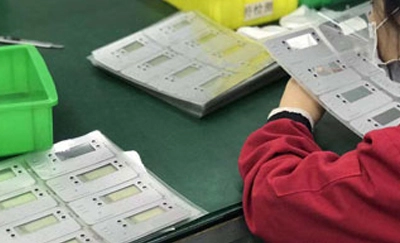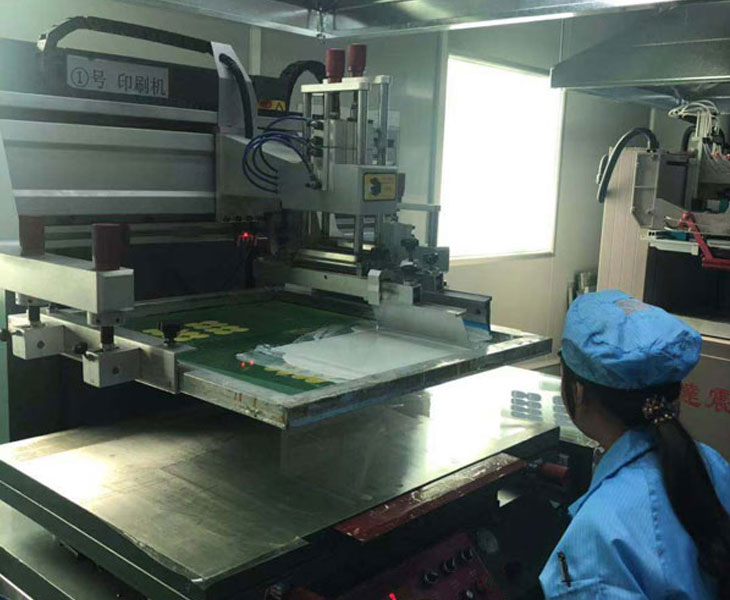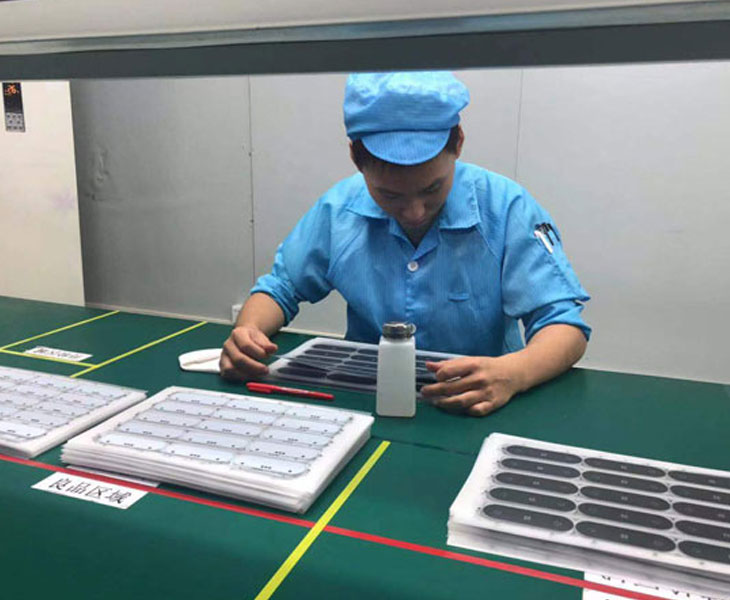
Membrane switch is a control system that integrates key functions, indicator components, and instrument panels. It is beautiful and light, with excellent electrical conductivity. It has the characteristics of waterproof, dustproof, antistatic interference, etc. It is widely used in electronic communications, medical equipment, industrial control, Instrumentation, automotive industry, smart home and other fields. The following is a brief introduction to the membrane switch production process.
Several common structures of membrane switches
The membrane switch structure is divided into five structural layers: panel layer, surface adhesive layer, upper circuit, interlayer (isolation layer), lower circuit and adhesive.The panel layer is generally made of high-toughness PET or PC transparent colorless sheet with a thickness of less than 0.25mm, printed with patterns and text, and its main function is to play the role of logo and keys;The surface adhesive generally uses a strong double-sided adhesive with a thickness of 0.05-0.15mm to closely connect the panel to the upper circuit; the upper and lower circuits are both 0.125mm thick (in some cases, 0.075 and 0.1mm thickness). Excellent polyester film (PET), screen-printed conductive silver paste and conductive carbon paste, drying and aging make it have conductive properties, the connection spacing of the circuit outlet is less than 1mm, the gold finger connection socket is easy to puncture the silver paste, causing defects It is recommended that the whole circuit use FPC with strong wear resistance to eliminate bad; the interlayer is to play the role of insulation and bonding between the upper circuit and the lower circuit. Generally, a double-sided tape with a PET substrate thickness of 0.1-0.25mm is used ; The bottom layer of adhesive should first consider what kind of material it is pasted with, and choose a strong double-sided adhesive that can be closely adhered to the pasting surface. Membrane switch is a whole, all materials should consider the overall sealing, waterproof, insulation and aging resistance, outdoor membrane switch, but also to consider the wind and rain, the temperature difference between winter and summer and the strong ultraviolet radiation of the sun.
Niceone-tech's engineering personnel should consider the overall design of the membrane switch, taking into account the scientific and technological characteristics, so that the products produced are stable, reliable, economical and practical.

Most of the membrane switch printing is done by silk screen.The early stage of silk screen printing is printing. Before printing, use film control samples to determine whether the membrane switch film is correct and whether it is damaged. Check whether the screen is cleaned, and whether there are dirt or broken holes. Generally, the circuit uses 100T The stencils and panels are exposed with 120T stencils (especially fine ones will use 140T or 160T stencils). Then compare the sample to determine whether the film is being sun-baked or back-baked.The preparation of ink is an important work in the screen printing process, which is directly related to the appearance quality of the membrane switch. Master colorists must master color knowledge and ink-adjusting process to make the matched ink bright, bright and accurate.Theoretically, any color can be mixed with different proportions of the three primary colors (magenta, yellow, and cyan). After equal amounts of the three primary colors are mixed and mixed, they can become black (approximately). The three primary colors of ink are mixed in equal amounts and white inks of different proportions are added to form a variety of gray inks with different tones. The three primary color inks are mixed in various proportions, and can be adjusted to a variety of intermediate or multiple colors with different hue, and the hue is biased to the primary hue with a larger proportion. The two primary colors inks can be mixed into the standard intermediate colors after equal mixing. After mixing the two primary colors inks in different proportions, they can be mixed into a variety of different colors. In addition, in any color ink, the hue appears brighter after adding white ink. Conversely, after adding black ink, its hue becomes darker.
Screen printing is divided into hand printing (sample printing), semi-automatic machine printing (small batch), automatic machine printing. Before installing the screen, first check the sample to check whether the screen is correct, whether the screen film is damaged, and whether it is reversed (special attention to the circuit). During the printing process, it is necessary to repeatedly check whether the color registration position of the printed product is consistent and accurate, and whether there are paste plates, dry nets, and dust particles. Each link must be repeatedly checked whether the product is perfect and flawless, to develop a good habit of self-inspection, and pay attention to keeping the workshop and work station clean and tidy, and choose a harmonious and efficient working environment.

The assembly is subdivided into punching, bubbling, shrapnel release, fitting, forming, and terminal punching.Punching is the key point for bubbling accuracy. Inaccurate hole position will cause the bubble key to not be centered, and at the same time it will be crooked during forming, resulting in defective products. The sampling position of the hole is set well. It depends on whether the vacant position is centered (the hole position offset cannot be greater than 0.05mm).The bubbling quality is closely related to the quality accuracy of the mold. If the mold key arc is too conical, the panel will not spring up after bubbling. If the mold key arc is too large, the panel will feel bad after bubbling. The height (0.3 ~ 0.5mm) is equal, and the force (160 ~ 390g force) is balanced.Membrane switches generally use nickel-plated shrapnel (guozi), when there are higher requirements for resistance stability and key sensitivity, gold-plated shrapnel (gold-plated terminals are also used in special cases). Before loading the shrapnel (guozi piece), arrange the shrapnel. Use tweezers to pick up the shrapnel and place the button on the circuit. Make sure the position is centered. For each shrapnel, use tweezers to make sure there is no double shrapnel. In the case of double shrapnel, the feel of the membrane switch will increase significantly, or even no feel.
Lamination is a concentrated embodiment of membrane switch assembly, which is to paste each structural layer of the membrane switch into a whole. First, stick the interlayer on the lower circuit, and then stick the upper circuit to the lower circuit (the elastic is embedded in the key of the interlayer, and then the elastic fixing layer is attached). Adhesive is attached to the back of the circuit; if the LED trace is a single structural layer, the light-transmitting part of the LED must be punched first, then the LED trace layer is attached, and the adhesive is attached to the back; finally the panel (the panel has (For transparent windows and lamp holes, the adhesive layer at the windows and lamp holes must be emptied). At each step of pasting, care must be taken that there are no bubbles and debris, and the colloid cannot be wrinkled (refer to the article "Assembly of Membrane Switch" for details).Stamping forming has strict requirements on the size, a small number of products can use a knife mold, the production process is irregularly checked with a caliper to check whether the size is accurate, whether the mold is deformed, it is best to have a shell test paste, and the mold should be stopped immediately. Redo the new model. A large number of products use steel molds, which have small deformation and more precise dimensions. According to the specific situation and customer requirements, the allowable tolerances of the drawings without tolerances are generally as follows:
General size (mm) Allowable tolerance (mm)
18 or less ± 0.1
18-50 ± 0.15
51-125 ± 0.2
126-250 ± 0.3
251 or more ± 0.4
The burrs and die bending dimensions of the membrane switch after stamping should not be greater than 0.2mm, and the position should be toward the side without conductors.The gold finger PIN distance is 2.54mm. Generally, the terminals of the membrane switch are equipped with black shells (there are very few requirements for 1.27mm PIN distance to hit the terminal). The terminals are divided into male and female terminals. The PIN distance is 1.27mm, 1.0mm, 0.5mm, generally do not hit the terminal, paste the reinforcement on the back of the gold finger, the reinforcement position is generally flush with the gold finger carbon paste on the back of the gold finger, according to the specified position in special cases.
The appearance of the membrane switch panel must not have obvious defects, such as missing strokes and different thicknesses; there are stains, light spots, deinking, stains, and scratches in the background color block; the transparent window is not clear (F150 and F200PET printing) Special attention to UV window fluid), overflow glue, residual glue, etc .no offset phenomenon (print offset offset ≤0.15mm; upper and lower key combination offset ≤0.3mm; circuit and key sheet, panel and key combination offset Position ≤0.3mm; the blank area around the back of the panel and circuit combination is offset ≤0.2mm; the bubble at the panel key and the substrate offset ≤0.5mm).The functional test requires 100% full inspection of the membrane switch, and there can be no open circuit, short circuit, poor insulation, etc .; LEDs with LED lights must not have LED leakage, and LEDs with resistance will quickly die. The membrane loop resistance value of each button of the membrane switch should not be greater than 80Ω. For loop lengths greater than 400mm and with special requirements for loop resistance, it is additionally specified on the drawing. In normal temperature and humidity environment, the insulation resistance between conductor lines is greater than 5000KΩ (500VDC for 1 minute). After high temperature and constant humidity test and salt spray test, it should be no less than 2000 KΩ.The life test requires that a single button be pressed under 2N, and the number of contact conduction should be greater than 1 million times (special requirements can be tested to 2 million times). However, check whether the surface of the button is deformed or damaged, tear the structural layer to see whether the internal structural layer of the press room is damaged, whether the key position is worn, and the life test is only a test in a relative time, without considering the actual use time span and use Changes in the environment.
High and low temperature test, stick the membrane switch to the shell, put it in the oven one week later, adjust the temperature to 60 ℃ constant temperature (± 2 ℃), after 72 hours of high temperature, take it out of the oven to cool, test the electrical performance Whether it conforms to the regulations, whether there is any change in the external dimensions, whether there is cracking and knocking. Similarly, put it in the freezer and withstand a constant temperature of -20 ℃ (± 2 ℃). After 120 hours of low temperature, remove it from the freezer and restore it to normal temperature. Wipe off the water droplets on the surface to test whether the electrical performance meets the regulations and whether the dimensions are Change, whether the glue cracks and knocks. For products requiring acid and alkali salt resistance, put the membrane switch into a solution containing 5% acid and alkali salt, and then take out the high and low temperature test to finally test whether the electrical performance and appearance meet the regulations.
The key point of packaging into the warehouse is to avoid heavy pressure. To prevent multiple products from overlapping and laying flat, all are required to be erected and discharged. The box can be considered to be loaded into a small box in a small box to prevent the key from being pressed for a long time. The outlet of the membrane switch should be well protected to avoid the possibility of bending of the outlet of the membrane switch under any circumstances. At the same time, the warehouse should be protected from moisture and dust, and there is no acid, alkali or other corrosive gases in the surrounding air.
⒈Working voltage: ≤50VDC
⒉ Working current: ≤100mA
⒊ Contact resistance: 0.5 ~ 10Ω
⒋Insulation resistance: ≥100MΩ (100VDC)
⒌ Base material withstand voltage: 2kVDC
⒍Rebound time: ≤6ms
⒎Loop resistance: ≤80Ω (single button loop line length within 40cm)
⒏Insulation ink withstand voltage: 100VDC
9. Reliability and service life:> 1 million times
10. Button strength: 160 ~ 450g force
11. Working temperature: -30 ℃ ~ + 50 ℃
12. Storage temperature: -20 ℃ ~ + 45 ℃ Humidity 95% ± 5%

If you need any customized membrane switch, as a membrane switch factory, we customize all kinds of membrane switches. If you want to know more about membrane switch technology, please feel free to contact. The membrane switches, silicone rubber keypad and plastic products we produce are of high quality and moderate price to help customers win more orders.